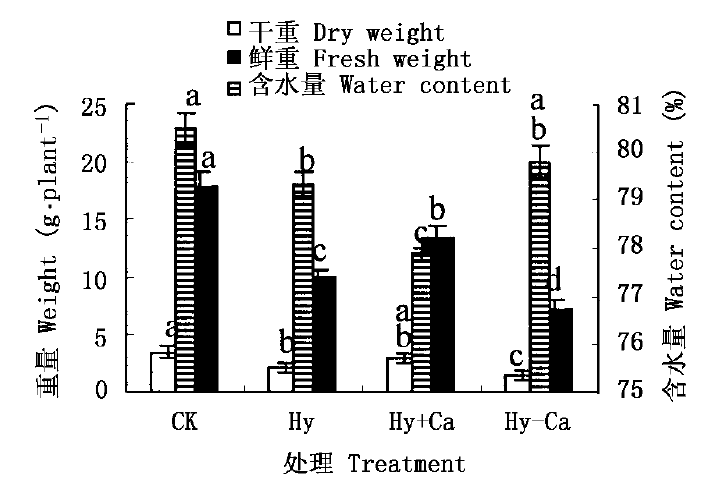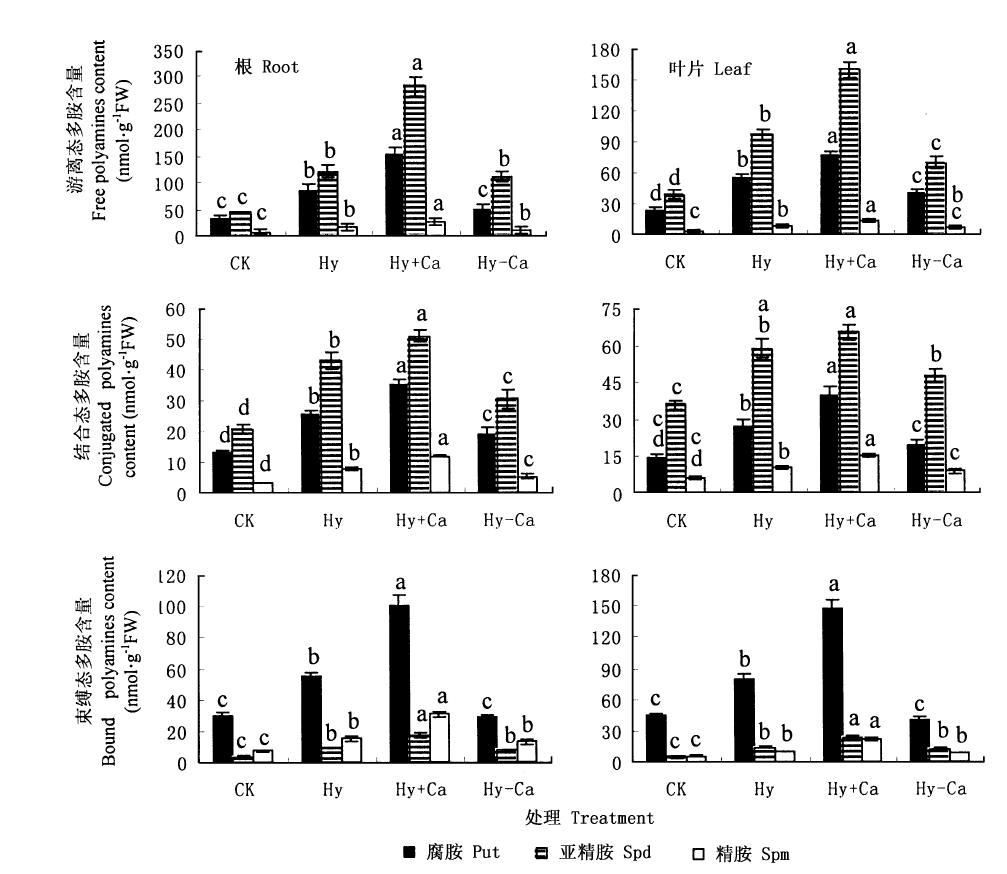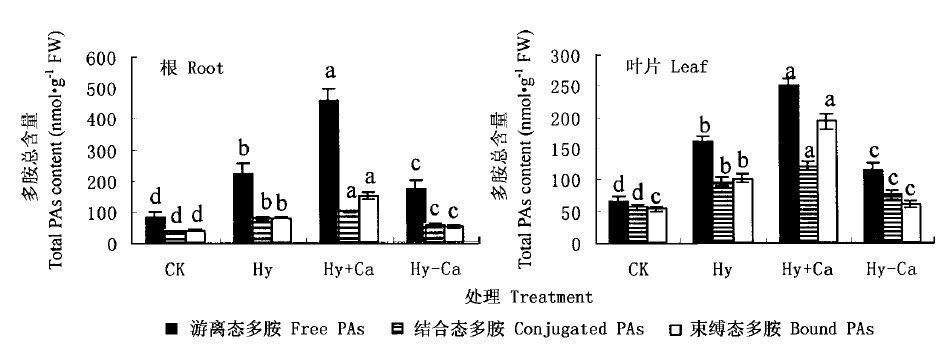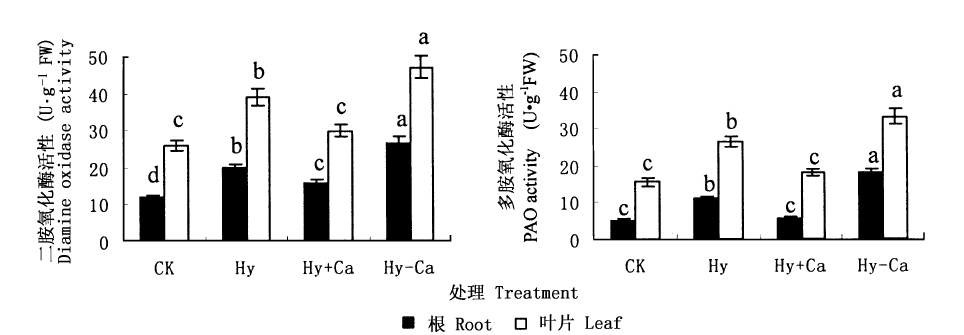

植物生态学报 ›› 2005, Vol. 29 ›› Issue (4): 652-658.DOI: 10.17521/cjpe.2005.0087
收稿日期:2004-08-02
接受日期:2004-12-31
出版日期:2005-08-02
发布日期:2005-07-31
通讯作者:
郭世荣
基金资助:
GAO Hong-Bo1, LIU Yan-Hong1,2, GUO Shi-Rong1,*( ), SUN Yan-Jun1
), SUN Yan-Jun1
Received:2004-08-02
Accepted:2004-12-31
Online:2005-08-02
Published:2005-07-31
Contact:
GUO Shi-Rong
About author:* E-mail: shirongguo@hotmail.com摘要:
以低氧性敏感的网纹甜瓜(Cucumis melo var. raticulalus)品种`西域一号'(Xiyu 1)为材料,研究了钙对低氧胁迫下幼苗生长、游离态、结合态和束缚态的腐胺(Put)、亚精胺(Spd)、精胺(Spm)含量、二胺氧化酶(DAO)和多胺氧化酶(PAO)活性、H2O2含量的影响。结果表明:与通气对照相比,低氧胁迫处理幼苗鲜重和干重显著降低,根、叶中3种形态的Put、Spd、Spm含量显著增加,DAO和PAO活性、H2O2含量显著提高;营养液加钙处理不但缓解了低氧胁迫对幼苗生长的抑制作用,而且幼苗游离态、结合态和束缚态Put、Spd、Spm含量显著高于单纯低氧胁迫处理,DAO和PAO活性、H2O2含量显著低于低氧胁迫处理;低氧胁迫下缺钙处理加重了低氧胁迫对网纹甜瓜幼苗的伤害。表明在低氧胁迫下,钙参与了网纹甜瓜幼苗多胺的代谢过程,对增强幼苗耐低氧性起着重要的作用。
高洪波, 刘艳红, 郭世荣, 孙艳军. 低氧胁迫下钙对网纹甜瓜幼苗多胺含量及多胺氧化酶活性的影响. 植物生态学报, 2005, 29(4): 652-658. DOI: 10.17521/cjpe.2005.0087
GAO Hong-Bo, LIU Yan-Hong, GUO Shi-Rong, SUN Yan-Jun. EFFECT OF CALCIUM ON POLYAMINE CONTENT AND POLYAMINES OXIDASE ACTIVITY IN MUSKMELON SEEDLINGS UNDER HYPOXIA STRESS. Chinese Journal of Plant Ecology, 2005, 29(4): 652-658. DOI: 10.17521/cjpe.2005.0087

图1 低氧胁迫(4 d)下钙对网纹甜瓜幼苗生长和含水量的影响 CK:对照 Control Hy: 低氧胁迫(2±0.2) mg·L-1 Hypoxia stress (2±0.2) mg·L-1 Hy+Ca: 低氧胁迫+10 mmol·L-1 Ca2+ Hypoxia stress+10 mmol·L-1 Ca2+ Hy-Ca: 低氧胁迫+0 mmol·L-1 Ca2+ Hypoxia stress+0 mmol·L-1 Ca2+
Fig.1 Effect of calcium on growth and water content in muskmelon seedlings under hypoxia stress after four days

图2 低氧胁迫下钙对网纹甜瓜幼苗游离态、结合态和束缚态多胺含量的影响 CK、Hy、Hy+Ca、Hy-Ca: 同图1 See Fig.1
Fig.2 Effect of Ca2+ on free, conjugated and bound polyamines contents in muskmelon seedlings under hypoxia stress

图3 低氧胁迫下钙对网纹甜瓜幼苗游离态、结合态和束缚态多胺总含量的影响 CK、Hy、Hy+Ca、Hy-Ca: 同图1 See Fig.1
Fig.3 Effect of Ca2+ on total polyamines contents of free, conjugated and bound contents in muskmelon seedlings under hypoxia stress

图4 低氧胁迫下钙对网纹甜瓜幼苗DAO和PAO活性的影响 CK、Hy、Hy+Ca、Hy-Ca: 同图1 See Fig.1
Fig.4 Effect of Ca2+ on DAO and PAO activities in muskmelon seedlings under hypoxia stress
| [1] | Dolferus R, Ellis M, de Bruxelles G, Trevaskis B, Hoeren F, Dennis ES, Peacock WJ (1997). Strategies of gene action in Arabidopsis during anoxia. Annals of Botany, 79,21-31. |
| [2] | Drew MC (1997). Oxygen deficiency and root metabolism: injury and acclimation under hypoxia and anoxia. Annual Review of Plant Physiology and Plant Molecular Biology, 48,223-250. |
| [3] |
Ellis MH, Dennis ES, Peacock WJ (1999). Arabidopsis roots and shoots have different mechanisms for hypoxic stress tolerance. Plant Physiology, 119,57-64.
URL PMID |
| [4] | Federico R, Angelini R (1991). Polyamine catabolism. In: Slocum RD, Flores HE eds. Biochemistry and Physiology of Polyamines in Plants. CRC Press, Boca Raton,41-56. |
| [5] | Gao HB (高洪波), Guo SR (郭世荣), Wang T(汪天) (2004a). Effect of hydroponic hypoxia stress on proline and polyamines contents of muskmelon seedlings. Plant Physiology Communication (植物生理学通讯), 40,434-436. (in Chinese) |
| [6] | Gao HB (高洪波), Guo SR (郭世荣), Wang T 汪天) (2004b). Effect of root-zone hypoxia on $NO_3^{-}-N$, $NH_4^{+}-N$ and protein contents of muskmelon seedlings. Acta Horticulturae Sinica (园艺学报), 31, 236-238. (in Chinese with English abstract) |
| [7] | Gao HB, Chen GL, Han LH, Lin H (2004). Calcium influence on chilling resistance of grafting eggplant seedlings. Journal of Plant Nutrition, 27,1327-1339. |
| [8] | Gong M, van der Liut A, Knight MR, Trewaveas AJ (1998). Heat-shock-induced changes in intracellular Ca2+ level in tobacco seedlings in relation to thermotolerance. Plant Physiology, 116,429-437. |
| [9] | Guan JF (关军锋), Liu HL (刘海龙), Li GM (李广敏) (2003). Changes of polyamines content and polyamine oxidase activity of roots and leaves during drought stress in wheat seedlings. Acta Phytoecologica Sinica (植物生态学报), 27,655-660. (in Chinese with English abstract) |
| [10] | Guo SR (郭世荣) (2003). Soilless Culture (无土栽培学). China Agriculture Press, Beijing, 127. (in Chinese) |
| [11] | Guo SR, Nada KY, Katoh HS, Tachibana SJ (1999). Differences between tomato and cucumber in ethanol, lactate and malate metabolisms and cell sap pH of roots under hypoxia. Journal of Japan Society Horticulture Science, 68,152-159. |
| [12] | Jiang XY, Song J, Fan H, Zhao KF (2000). Regulations of exogenous calcium and spermidine on ion balance and polyamine levels in maize seedlings under NaCl stress. Acta Phytophysiology Sinica (植物生理学报), 26,539-544. |
| [13] | Kakkar RK, Sawhney VK (2002). Polyamine research in plants—a changing perspective. Physiology Plantarum, 116,281-292. |
| [14] | Liu HP, Dong BH, Zhang YY, Liu ZP, Liu YL (2004). Relationship between osmotic stress and the levels of free, conjugated and bound polyamines in leaves of wheat seedlings. Plant Science, 166,1261-1267. |
| [15] | Liu J (刘俊), Liu YL (刘友良) (2004). The relations between polyamine types and forms and polyamine oxidase activities in barley seedlings under salt stress. Jouranl of Plant Physiology and Molecular Biology (植物生理与分子生物学学报), 30,141-146. (in Chinese with English abstract) |
| [16] | Ren HX (任红旭), Chen X (陈雄), Wang YF (王亚馥) (2001). Changes in antioxidative enzymes and polyamines in wheat seedlings with different drought resistance under drought and salt stress. Acta Phytoecologica Sinica (植物生态学报), 25,709-715. (in Chinese with English abstract) |
| [17] | Santa-Gruz A, Bolarin C (1997). Changes in free polyamine levels induced by salt stress in leaves of cultivated and wild tomato species. Physiology Plantarum, 101,341-346. |
| [18] | Song JJ, Nada K, Tachibana SJ (2002). Suppression of S-adenosylmethionine decarboxylase activity is a major cause for high-temperature inhibition of pollen germination and tube growth in tomato. Plant Cell Physiology, 43,619-627. |
| [19] | Sukar R, Chinta S, Ramanjulu S (2001). Alleviation of NaCl salinity stress by calcium is partly related to the increased proline accumulation in mulberry (Morus alba L.) callus. Journal of Plant Biology, 28,203-206. |
| [20] | Sulochana C, Rao TJVS, Savithramma N (2002). Effect of calcium on water stress amelioration through calmodulin and scavenging enzymes in groundnut. Indian Journal of Plant Physiology, 7,152-158. |
| [21] | Tan JX (檀建新), Dong YH (董永华), Zhang W (张伟), Li GM (李广敏), Shang ZQ (商振清), Han JM (韩建民) (1998). Effect of calcium on content of endogenous hormones and polyamines in maize seedlings under osmotic stress. Plant Physiology Communication (植物生理学通讯), 34,94-96. (in Chinese) |
| [22] | Uchida A, Andre TJ, Takashi H (2002). Effects of hydrogen peroxide and nitric oxide on both salt and heat stress tolerance in rice. Plant Science, 163,515-523. |
| [23] | Wang T (汪天), Guo SR (郭世荣), Liu J (刘俊), Gao HB (高洪波) (2004). An improved method for measuring polyamine oxidase and it's application to the study of cucumber root under hypoxia stress. Plant Physiology Communication (植物生理学通讯), 40,358-360. (in Chinese) |
| [24] |
Xiong L, Schumaker KS, Zhu JK (2002). Cell signaling during cold, drought, and salt stress. Plant Cell, 14,165-183.
URL PMID |
| [25] | Zhao FG, Sun C, Liu YL, Zhang WH (2003). Relationship between polyamine metabolism in roots and salt tolerance of barley seedlings. Acta Botanica Sinica (植物学报), 45,295-300. |
| [26] | Zhao FG, Sun C, Liu YL, Liu ZP (2000). Effect of salinity stress on the levels of convalently and noncovalently bound polyamines in plasma membrane and tonoplast isolated from leaves and roots of barley seedlings. Acta Botanica Sinica (植物学报), 42,920-926. |
| [1] | 孟庆静, 樊卫国. 刺梨的适钙类型及对高钙生境的适应性[J]. 植物生态学报, 2022, 46(12): 1562-1572. |
| [2] | 赵鑫, 王文娟, 王普昶, 黄莉娟, 赵丽丽. 不同钙浓度对宽叶雀稗幼苗的生长和抗性生理的影响[J]. 植物生态学报, 2019, 43(10): 909-920. |
| [3] | 徐丽娇, 郝志鹏, 谢伟, 李芳, 陈保冬. 丛枝菌根真菌根外菌丝跨膜H +和Ca 2+流对干旱胁迫的响应[J]. 植物生态学报, 2018, 42(7): 764-773. |
| [4] | 孟德云, 侯林琳, 杨莎, 孟静静, 郭峰, 李新国, 万书波. 外源多胺对盆栽花生盐胁迫的缓解作用[J]. 植物生态学报, 2015, 39(12): 1209-1215. |
| [5] | 张佳蕾, 郭峰, 孟静静, 于晓霞, 杨莎, 张思斌, 耿耘, 李新国, 万书波. 酸性土施用钙肥对花生产量和品质及相关代谢酶活性的影响[J]. 植物生态学报, 2015, 39(11): 1101-1109. |
| [6] | 康丽娜, 吴福忠, 杨万勤, 谭波, 夏磊. 铅胁迫对欧美杂交杨幼苗碳、氮和磷积累与分配的影响[J]. 植物生态学报, 2012, 36(6): 578-586. |
| [7] | 王芳妹, 蔡妙珍, 张淑娜, 王宁, 李华飞, 胡雪娜, 虞舒航. NO和H2O2诱导大豆根尖和边缘细胞耐铝反应的 作用[J]. 植物生态学报, 2011, 35(9): 981-989. |
| [8] | 郭柯, 刘长成, 董鸣. 我国西南喀斯特植物生态适应性与石漠化治理[J]. 植物生态学报, 2011, 35(10): 991-999. |
| [9] | 王程媛, 王世杰, 容丽, 罗绪强. 茂兰喀斯特地区常见蕨类植物的钙含量特征及高钙适应方式分析[J]. 植物生态学报, 2011, 35(10): 1061-1069. |
| [10] | 姬飞腾, 李楠, 邓馨. 喀斯特地区植物钙含量特征与高钙适应方式分析[J]. 植物生态学报, 2009, 33(5): 926-935. |
| [11] | 孙艳军, 郭世荣, 胡晓辉, 高洪波. 根际低氧逆境对网纹甜瓜幼苗生长及根系呼吸代谢途径的影响[J]. 植物生态学报, 2006, 30(1): 112-117. |
| [12] | 李璟, 胡晓辉, 郭世荣, 王素平, 王鸣华. 外源亚精胺对根际低氧胁迫下黄瓜幼苗根系多胺含量和抗氧化酶活性的影响[J]. 植物生态学报, 2006, 30(1): 118-123. |
| [13] | 关军锋, 刘海龙, 李广敏. 干旱胁迫下小麦幼苗根、叶多胺含量和多胺氧化酶活性的变化[J]. 植物生态学报, 2003, 27(5): 655-660. |
| [14] | 赵福庚, 孙诚, 章文华, 刘友良. 盐胁迫对大麦叶片类囊体膜上两种形态多胺含量和膜蛋白合成的影响[J]. 植物生态学报, 2003, 27(1): 137-140. |
| [15] | 任红旭, 陈雄, 王亚馥. 抗旱性不同的小麦幼苗在水分和盐胁迫下抗氧化酶和多胺的变化[J]. 植物生态学报, 2001, 25(6): 709-715. |
| 阅读次数 | ||||||
|
全文 |
|
|||||
|
摘要 |
|
|||||
Copyright © 2022 版权所有 《植物生态学报》编辑部
地址: 北京香山南辛村20号, 邮编: 100093
Tel.: 010-62836134, 62836138; Fax: 010-82599431; E-mail: apes@ibcas.ac.cn, cjpe@ibcas.ac.cn
备案号: 京ICP备16067583号-19